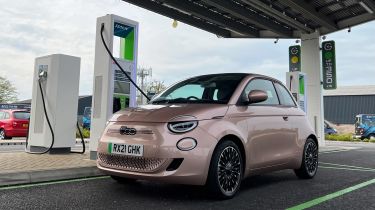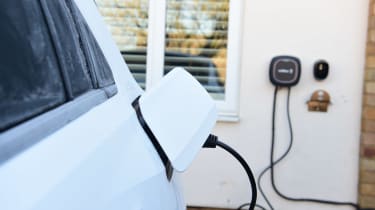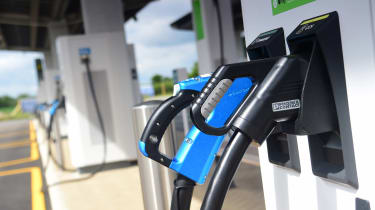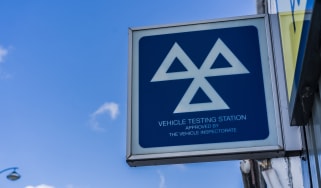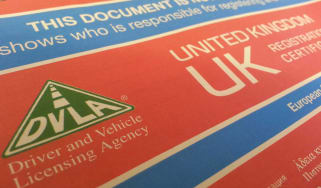Electric car charging in the UK: prices, networks, charger types and top tips
Keeping your EV battery topped-up is easier than ever. Here’s all you need to know about charging an electric car today
As the world continues to make the switch to electric cars, the UK’s EV charging infrastructure is continuing to improve. Whether you want to charge an electric car at home via a wallbox installation or hook up to a high-speed public charging point, the options for charging an electric car are broader than ever.
The electric car charging map is expanding rapidly, too, with more and more locations — such as car parks, supermarkets and service stations — offering at least one charging station. Search hard enough and you can even find free electric car charging points, further widening the already-huge running cost gap between combustion cars and EVs.
Below we explain everything you need to know about charging an electric car in the UK, at home or in pubic. The charging networks, charger types, electricity tariffs, costs and convenience; it’s all covered here along with some top tips to help you through life with an electric car…
Where can I charge an electric car?
There are a number of options to choose from when you need to charge your electric car, whether you’re at home, on the road, at the office or even out shopping. The UK’s public EV charging network is continuing to expand at a considerable rate, and there are now a number of providers with rapid-charging points at key locations including motorway service stations, car parks and petrol stations.
Of course, you can always charge at home, too. The option that will work best for you will depend on your circumstances at the time you want to plug in, so here are your choices.
At home
Whether it’s overnight while you sleep or simply during your day off, charging at home is normally the cheapest and most convenient option for many drivers. However, it is also much slower than charging at a public rapid-charging station, so you will need to plan ahead.
There are two ways to charge an EV at home. Firstly, you can simply plug your car into a standard three-pin plug socket. However, this is far slower than using a dedicated charger and will only top-up your battery at a rate of up to 3kW — hence it is sometimes referred to as ‘trickle charging’.
The faster and much more convenient way to charge at home is by having a dedicated home wallbox charger installed. These units typically charge at 7kW, although a few houses may have a three-phase 400v electricity supply allowing charging at up to 22kW these are more often found in commercial properties.
Although you will have to pay for a wallbox installation, you should soon make your money back if you compare the cost to how much extra you’d spend if you were regularly using a public charger.
At work
We might not want to admit it, but many of us spend a considerable amount of our daily lives in the workplace. So, if you can come out to a topped-up battery at the end of each day, that’d be highly ideal.
A number of workplaces with their own car parks, such as office blocks, have at least one EV charging station installed for their workers. If you’re particularly fortunate, this will also be free to use. While it’s more likely that your employer will fork out for a standard fast-charger rather than a rapid one, this will still add a considerable number of miles to your car’s range while you work, especially if your place of work has three-phase electrics allowing up to 22kW charging.
In public
Many public locations including supermarkets, shopping centres, pay-and-displays, railway stations and tourist attractions are all starting to install EV charging stations in their car parks. Just watch out for any additional parking fees and restrictions.
Public chargers will often be fast chargers in the 7 to 22kW range but rapid chargers are also becoming an increasingly common sight at local filling stations and motorway service stations with charging speeds well over 100kW. Dedicated EV charging centres are also starting to appear across the country. Many of these are essentially service stations, complete with shops, cafes and toilets, but without traditional the fuel pumps.
How do I find an electric car charger near me?
It would be foolhardy to undertake a journey of any significance in an electric car without planning ahead. Fortunately, technology is at hand to make finding a nearby charger as easy as can be.
The vast majority of modern electric cars are fitted with sat-nav as standard, so it’s only natural that these systems display charger locations. However, this feature only appears on a select number of models, so be sure to check before you set off. If your car doesn’t have in-built sat-nav, or doesn’t show this information, your phone will be the next port of call.
There are a number of specialist websites and mobile apps that provide live electric car charging maps that cover the entirety of the UK, such as Zap-Map. You can either use your phone’s GPS tracking or enter a postcode to tell the interactive map where you are, and it’ll then show you every nearby charging station that’s listed on its database.
Several of these apps, such as those which are managed by EV charging networks, will also display live information including whether the charger is working, if it’s occupied, what the maximum charging speed is and how much it costs.
General navigation apps, such as Google Maps, are also starting to display EV charger locations. This means you can still see the directions to your final destination as well as the charging options en route.
As useful as it is, online information is user-generated in some cases, so it’s not always up to date. We’d recommend taking the precaution of double-checking potential charging stations ahead of your arrival. You’ll want to make sure that they’re functional and suited to the vehicle you’re driving.
You can find the best EV charging apps right here…
How do I charge an electric car at home?
There are two options if you want to charge at home: a traditional three-pin plug or a home wallbox charger.
While a three-pin plug is ideal for charging for your phone, an electric car’s battery is much bigger and, unsurprisingly, requires a lot more power. A regular plug can indeed charge your EV, but it’ll take a very long time to do so.
A typical household socket delivers electricity at a rate of between 1-3kW. At this speed it’d take over a day to fully charge an entry-level Tesla Model 3’s battery from 0 to 100 per cent, which is far from practical. Because of this, some manufacturers don’t recommend using a three-pin plug, even when it’s included with the car, unless there is absolutely no other choice.
The alternative and far more convenient option is having a home wallbox charger installed. This is a unit that is specifically designed for charging electric vehicles, and it delivers almost three times as much power as a regular plug. You will need to arrange for one of these units to be fitted by a specialist installer, but there are several of these to choose from with many covering the entire country.
Once fitted, a modern 7kW home wallbox charger unit will fully-charge the same Tesla Model 3 in just over nine hours, which is easily achievable if you plug it in overnight. This means you can wake up to a full ‘tank’ every morning, without having to drive anywhere to fill up.
This shorter time frame makes a 200-mile round-trip commute feasible in a modern electric car, and it will cost significantly less in electricity than it would to buy fuel for a petrol or diesel car — especially if you can top up at work for free.
The only catch here is that you will need a driveway or private parking space in order to have a wallbox installed. If, like many people, you don’t have this luxury, you do still have options. Although you’ll need permission from your local authority, there are under-pavement charging solutions available. These will allow you to feed a cable from your home to a roadside parking space without posing a trip hazard to pedestrians.
If this isn’t practical, there are also an increasing number of roadside public chargers being rolled out across the country, so you may not have to wait too long for one to appear outside your home.
You can read our full guide to home electric car chargers or read more about electric car charging at home with no driveway here…
How do I charge an electric car at a public charger?
If you don’t have a charger at home or are simply too far away, you may wish to recharge or at least top up your car’s battery at a public charging station instead. Depending on where you decide to charge, you will be faced with either a slow-, fast-, or rapid-charger (or in some cases a combination of speed options). Hooking up to any of these should prove straightforward.
Some public chargers, particularly smaller roadside units, are often untethered. This means you will need to use your car’s own cable. Other units are tethered, which means they have their own cables pre-attached.
Once connected, you will need to begin the charging session, and this process can vary between different charging stations. Some chargers will simply start as soon as they’re connected, but others will require confirmation via inbuilt buttons, a mobile app or a membership or contactless payment card. Remember that technology can misbehave, so try not to wander off until you’ve confirmed that the charging process has definitely begun.
While your car is connected, many charging stations will provide useful live information such as the current charging speed and the accumulated total price. If you have your car connected to an app on your phone you can check on its charging status remotely before your return.
Once the charge is complete, payment will then be taken automatically via a pre-selected method. This is usually via a pre-scanned contactless card or the user’s account on the provider’s app.
If you don’t want to upset your fellow EV owners, the best etiquette is to move your car once it has finished charging so someone else can then use the chargepoint. Don’t treat public charging facilities as a way of getting cheap parking but also, be aware of any general parking time limits in the car park where the charger is located as these will apply to you whether charging or not.
Electric car charging networks
The UK’s electric car charging network is growing steadily, and there are now several key providers with facilities across the country. Some of the most common brands that you’ll find at locations such as motorway service stations and petrol stations include Ionity, BP Pulse, Shell Recharge, Gridserve, Instavolt and the Tesla Supercharger network.
A number of companies also have multiple charge points located in more urban locations, such as supermarkets, pay-and-display car parks and specially-built charging stations. These include Pod Point, Fastned, Osprey and MFG (Motor Fuel Group).
If there’s a specific brand of charger that you would like to find, the vast majority of providers have a network map on their respective websites and apps. Brand loyalty can pay off, too, as some operators offer discounted rates to customers who’ve signed up to use their services. If you use the same network regularly, it’s well worth taking advantage of these promotions.
BP Pulse, for example, offers three charging options: there’s a full member rate which commands a monthly fee, and this opens up access to hundreds of free-to-use chargers, as well as low rates for fast and rapid chargepoints. There’s also a free membership where you provide your details and use the chargers on a pay-as-you-go basis at a reduced rate. Finally, the contactless bank card option has the most expensive rate per kWh but there’s no need to log-in; just swipe and charge.
There’s loads of choice! So we’ve asked EV owners to pick out the best electric car charging stations…
What are the different types of electric car charger?
Electric car chargers can look very different to one another, because they are manufactured and installed by different networks. However, it’s generally the charging speed that your car can handle which determines the type of charger and connectors you need. Here’s an overview of the main types.
Slow chargers
This is the most basic charger that’s supplied with electric cars, and it’ll allow you to charge overnight using a standard 13-amp three-pin plug. It’s important to note that some manufacturers don’t recommend charging from a household socket unless it’s an emergency.
A typical maximum current draw of up to 3kW means fully charging a modern electric car can take in excess of 24 hours. While this is obviously next to useless if you need to use your EV daily, we would always advise drivers to carry their slow charger as a backup. It’s still better than nothing if you’re running critically low.
Slow charger connectors
- Three-pin plug: This is the exact same plug that you use for charging your phone, but this means that it draws very little power for a whopping great EV battery. Several electric car makers recommend only using this in an emergency situation.
- Commando: This is an industrial plug fitting that is commonly found in the UK but seldom used for charging EVs. These units are usually weatherproof and can deliver up to 7kW of power. Commandos are a very basic bit of kit compared to dedicated home wallbox chargers, though, and they lack the useful extra features.
Fast chargers
Fast chargers at least double the rate of charge that you can pump into an EV’s battery, and this will significantly reduce the typical charging time to just a few hours. Fast chargers typically operate at 7.4kW in home wallbox form, but public units can go even faster.
Public installations of these chargers can be found in various places, including the roadside, car parks and supermarkets.
If you’re looking for a quick top-up, fast chargers will still take quite a long time. However, for charging overnight at home while you sleep or in the office car park while you go about your working day, these units can prove very effective.
Fast charger connectors
- Type 1: If you’re buying second hand you might come across a Type 1 cable, but most modern EVs now use Type 2. The Type 1 connection is a circular design with five pins and a latch to hold it in place, but crucially it doesn’t lock. It can also only charge up to speeds of 7.4kW.
- Type 2: This is now the standard cable across the EV world. The connector has a seven-pin layout and locks in place, unlike a Type 1 cable. Type 2 also features three-phase charging, meaning potential speeds of up to 43kW from public chargers.
Rapid chargers
Most modern electric cars have now been developed to take a high-speed charge — up to 350kW in the case of some Hyundai and Kia models - if you can find a charger to deliver that kind of power. Even if your car can’t quite manage this speed, many models can still be charged from 10 to 80 per cent in less than 30 minutes.
The reason why we (and many car manufacturers) quote charging times in for a 10 to 80 per cent top-up is because a complete rapid charge from 0 to 100 per cent can weaken the battery’s cells over time and is not recommended. Don’t worry about doing this accidentally or in an emergency, though, because most modern EVs will automatically slow down the charging process to prevent damage from happening. As a result, a full charge will take a bit longer.
Rapid charger connectors
- CHAdeMO: This is the now-defunct Japanese equivalent to a CCS connector. You will only find these on older EVs such as the Nissan Leaf. CHAdeMOs can carry up to 50kW and require their own specific socket.
- CCS: The Combined Charging System is a very common connector on modern EVs which are currently sold in the UK. CCS units vary in power, and the maximum that a select number of EVs can currently receive is 350kW. Even if your car can’t quite handle this much, a CCS is still most likely to be the connector you’ll use when hooking up to a rapid-charging station. CCS setups are made up of both AC and DC connectors (one of which is normally a Type 2) and this allows them to be used at multiple speeds.
Which charger is the best for your car? We explain the electric car charger types in detail…
How long does it take to charge an electric car?
How long an electric car will take to charge will depend on the size of its battery and the speed of the charger that’s being used. The formula for working out your car’s charging time looks like this:
Battery size (kWh) ÷ charger power (kW) = charging time in hours
If we use a Hyundai Ioniq 5 fitted with a 58kWh battery as an example, the charging times will look like this:
- 58kWh ÷ 2.5kW (slow charger) = 23.2 hours
- 58kWh ÷ 7.4kW (home wallbox charger) = 7.8 hours
- 58kWh ÷ 43kW (fast public charger) = 1.3 hours
- 58kWh ÷ 240kW (rapid public charger) = 0.24 hours
As you can see, public chargers are the better option if you only need a quick top-up. Don’t forget, though, that charging at home is often much cheaper, and although it’s slower, a home wallbox can still complete a full charge overnight, meaning your car is ready to go the following morning. If you’re only driving 20 miles or so each day, you may only need to charge once a week.
How much does it cost to charge an electric car?
If you’re charging your EV at home, any costs incurred will simply be added to your electricity bill just like any other device. This will be priced at a set rate per kilowatt/hour (kWh). Of course, electric cars require a fair share of ‘juice’ so some providers now offer plans that are specifically designed for those who charge electric cars at home that offer cheaper electricity in overnight.
As with any utility, it can really pay to shop around and compare providers. You will probably need a smart electricity meter for one of the specialist EV electricity tariffs and although they offer cheaper charging at off-peak times they tend to be more expensive during the day when you are using electricity at home for other reasons. Make sure an EV tariff really is the cheapest option for you.
If you want to charge while you’re out and about, it’s helpful to have a smartphone. Despite the requirement for newly-built chargers to have contactless payment options, some networks offer discounts if you subscribe to their services via their respective mobile apps. Some providers will even provide a QR code on their chargers so you can download the appropriate app with ease.
If you want to pay for your charging via an app, you’ll need to enter your credit or debit card info, and you’ll then be charged based on the time taken and power used. The phone sends commands directly to the chargepoint, telling it to start and stop, and to open access flaps.
Access and electricity costs vary. Some venues such as hotels and shopping centres give power away for free, but each public chargepoint provider will have its own rates. Rapid chargers are generally more expensive, reflecting the fact that they can cram more electricity into the battery in a shorter time.
Just like when calculating the charging speed, the formula for calculating the cost to charge your EV is also a simple one:
Battery size x electricity cost (pence/kWh) = total cost for a full charge
Here are some of the main UK chargepoint providers’ rates, and how much it’d cost to charge our example Hyundai Ioniq 5 with 58kWh battery.
|
Rapid charging | |||
|
Provider |
Contactless price (per kWh) |
Total price |
Member price (per kWh) |
|
BP Pulse |
85p |
£49.30 |
69p |
|
Gridserve |
79p |
£45.82 |
N/A |
|
Ionity |
74p |
£42.92 |
56p |
|
MFG |
79p |
£45.82 |
N/A |
|
Osprey |
79p |
£45.82 |
N/A |
|
Shell Recharge |
93p |
£53.94 |
89p |
|
Fast charging | |||
|
BP Pulse |
79p |
£45.82 |
63p |
|
Gridserve |
49p |
£28.42 |
N/A |
|
MFG |
79p |
£45.82 |
N/A |
|
Shell Recharge |
93p |
£53.94 |
89p |
|
Osprey |
79p |
£45.82 |
N/A |
|
Slow charging | |||
|
BP Pulse |
59p |
£34.22 |
44p |
|
Shell Recharge |
79p |
£44.66 |
75p |
*prices correct as of April 2024
As you can see, prices can vary between providers, and rapid chargers are the priciest way to pay for a full charge. If you’re hoping to save the pennies, these are best left to quick top-ups when you're out and about. Charging at home will almost always be the cheapest option. In some cases, if you’re lucky, your workplace may offer a free chargepoint which you can use instead.
It makes sense for frequent public charger users to forget contactless or pay-as-you-go services and instead subscribe to the service which they use the most. This speeds up access and can makes charger use much cheaper. Most will find it’s better value for money if they require a rapid charge more than once a month, or a standard top-up once a week. There are ways to rapid charge for free, though. Some dealers will let you use their chargers for free during working hours.
Don’t pay a penny more than you have to! We explain more about free electric car charging and where to find it…
Is it worth all the effort?
If you have access to charging at home or work, you’ll be able to run an electric car for a fraction of the cost of a petrol or diesel car. If you charge at public points only, the savings will be far less, and there’s the extra stress of finding a spot. However, if you merely use these chargers for the occasional long trip, the ever-growing network – plus the increased range of EVs – makes these cars a practical proposition for thousands of motorists.
Top tips for EV charging
1. Get a good home charger
A dedicated home charging point will often be fitted for free when you buy a new electric car. The Government’s electric vehicle chargepoint grant can also help towards the cost of a home wallbox charger.
2. Get a good electricity deal
Check your electricity supplier’s prices. It makes sense to move to a deal that has the lowest price per kWh but a higher standing charge, as you will become a heavy user. If you will charge your car mostly at night, consider a tariff with cheaper rates in the early hours. Be aware, though, that electric car deals are sometimes more expensive during the day when you may still be using a lot of electricity in your home.
Many electric cars have a programmable charging timer that can make the most of cheap rate electricity when it is available.
3. Plan ahead
If you plan longer journeys carefully, they needn’t be stressful. A number of navigation systems and apps such as Zap Map are highly detailed, telling you what type of chargers are available and whether they’re currently working.
4. Check your phone reception
When using a public charge point controlled by an app, make sure your mobile phone reception is strong enough to receive data. Otherwise you could be waiting a while for the instructions to reach the charge post. This problem can be prevalent in multi-storey car parks or places with a lot of people, such as shopping centres and theme parks.
5. Be polite
EV owners are generally friendly, and most will move off a charging spot once they have enough power to get home – leaving it free for another driver to use. Make sure you follow this etiquette, too, or you could be seriously inconveniencing someone.
6. On the spot
Despite clear markings and the threat of fines, some internal-combustion engine car drivers still park in EV charging spots. This is commonly referred to as being ‘ICEd’. If you really need to charge and are blocked, ask a staff member to make an announcement asking the driver to move.
Ready to make the switch? These are the best electric cars to buy...
Find a car with the experts

